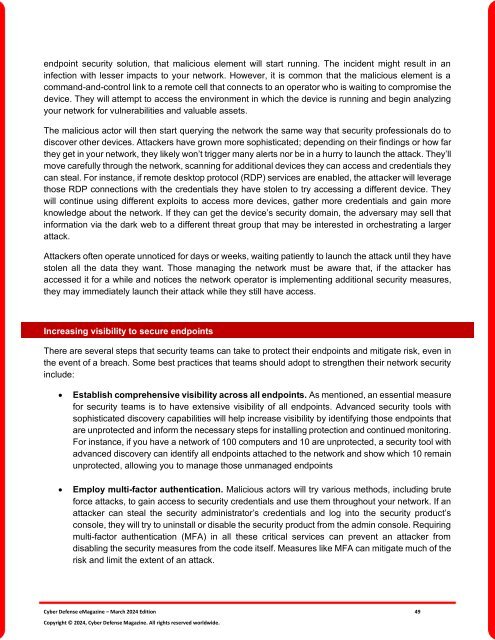The Cyber Defense eMagazine March Edition for 2024
Cyber Defense eMagazine March Edition for 2024 #CDM #CYBERDEFENSEMAG @CyberDefenseMag by @Miliefsky a world-renowned cyber security expert and the Publisher of Cyber Defense Magazine as part of the Cyber Defense Media Group as well as Yan Ross, Editor-in-Chief and many more writers, partners and supporters who make this an awesome publication! 225 page March Edition fully packed with some of our best content. Thank you all and to our readers! OSINT ROCKS! #CDM #CDMG #OSINT #CYBERSECURITY #INFOSEC #BEST #PRACTICES #TIPS #TECHNIQUES
Cyber Defense eMagazine March Edition for 2024 #CDM #CYBERDEFENSEMAG @CyberDefenseMag by @Miliefsky a world-renowned cyber security expert and the Publisher of Cyber Defense Magazine as part of the Cyber Defense Media Group as well as Yan Ross, Editor-in-Chief and many more writers, partners and supporters who make this an awesome publication! 225 page March Edition fully packed with some of our best content. Thank you all and to our readers! OSINT ROCKS! #CDM #CDMG #OSINT #CYBERSECURITY #INFOSEC #BEST #PRACTICES #TIPS #TECHNIQUES
You also want an ePaper? Increase the reach of your titles
YUMPU automatically turns print PDFs into web optimized ePapers that Google loves.
endpoint security solution, that malicious element will start running. <strong>The</strong> incident might result in an<br />
infection with lesser impacts to your network. However, it is common that the malicious element is a<br />
command-and-control link to a remote cell that connects to an operator who is waiting to compromise the<br />
device. <strong>The</strong>y will attempt to access the environment in which the device is running and begin analyzing<br />
your network <strong>for</strong> vulnerabilities and valuable assets.<br />
<strong>The</strong> malicious actor will then start querying the network the same way that security professionals do to<br />
discover other devices. Attackers have grown more sophisticated; depending on their findings or how far<br />
they get in your network, they likely won’t trigger many alerts nor be in a hurry to launch the attack. <strong>The</strong>y’ll<br />
move carefully through the network, scanning <strong>for</strong> additional devices they can access and credentials they<br />
can steal. For instance, if remote desktop protocol (RDP) services are enabled, the attacker will leverage<br />
those RDP connections with the credentials they have stolen to try accessing a different device. <strong>The</strong>y<br />
will continue using different exploits to access more devices, gather more credentials and gain more<br />
knowledge about the network. If they can get the device’s security domain, the adversary may sell that<br />
in<strong>for</strong>mation via the dark web to a different threat group that may be interested in orchestrating a larger<br />
attack.<br />
Attackers often operate unnoticed <strong>for</strong> days or weeks, waiting patiently to launch the attack until they have<br />
stolen all the data they want. Those managing the network must be aware that, if the attacker has<br />
accessed it <strong>for</strong> a while and notices the network operator is implementing additional security measures,<br />
they may immediately launch their attack while they still have access.<br />
Increasing visibility to secure endpoints<br />
<strong>The</strong>re are several steps that security teams can take to protect their endpoints and mitigate risk, even in<br />
the event of a breach. Some best practices that teams should adopt to strengthen their network security<br />
include:<br />
• Establish comprehensive visibility across all endpoints. As mentioned, an essential measure<br />
<strong>for</strong> security teams is to have extensive visibility of all endpoints. Advanced security tools with<br />
sophisticated discovery capabilities will help increase visibility by identifying those endpoints that<br />
are unprotected and in<strong>for</strong>m the necessary steps <strong>for</strong> installing protection and continued monitoring.<br />
For instance, if you have a network of 100 computers and 10 are unprotected, a security tool with<br />
advanced discovery can identify all endpoints attached to the network and show which 10 remain<br />
unprotected, allowing you to manage those unmanaged endpoints<br />
• Employ multi-factor authentication. Malicious actors will try various methods, including brute<br />
<strong>for</strong>ce attacks, to gain access to security credentials and use them throughout your network. If an<br />
attacker can steal the security administrator’s credentials and log into the security product’s<br />
console, they will try to uninstall or disable the security product from the admin console. Requiring<br />
multi-factor authentication (MFA) in all these critical services can prevent an attacker from<br />
disabling the security measures from the code itself. Measures like MFA can mitigate much of the<br />
risk and limit the extent of an attack.<br />
<strong>Cyber</strong> <strong>Defense</strong> <strong>eMagazine</strong> – <strong>March</strong> <strong>2024</strong> <strong>Edition</strong> 49<br />
Copyright © <strong>2024</strong>, <strong>Cyber</strong> <strong>Defense</strong> Magazine. All rights reserved worldwide.

















